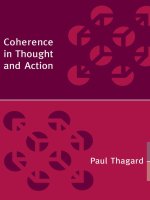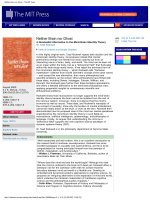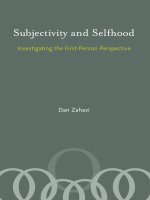the mit press probabilistic linguistics apr 2003
Bạn đang xem bản rút gọn của tài liệu. Xem và tải ngay bản đầy đủ của tài liệu tại đây (5.1 MB, 464 trang )
Probabilistic Linguistics
This page intentionally left blank
Probabilistic Linguistics edited by Rens Bod, Jennifer
Hay, and Stefanie Jannedy
The MIT Press
Cambridge, Massachusetts
London, England
62003 Massachusetts Institute of Technology
All rights reserved. No part of this book may be reproduced in any form by any
electronic or mechanical means (including photocopying, recording, or informa-
tion storage and retrieval) without permission in writing from the publisher.
This book was set in Times New Roman on 3B2 by Asco Typesetters, Hong
Kong. Printed and bound in the United States of America.
Library of Congress Cataloging-in-Publication Data
Probabilistic linguistics / editors: Rens Bod, Jennifer Hay, Stefanie Jannedy.
p. cm.
‘‘ . . . originated as a symposium on ‘Probability theory in linguistics’ held in
Washington, D.C. as part of the Linguistic Society of America meeting in
January 2001’’—Preface.
‘‘Bradford books.’’
Includes bibliographical references and index.
ISBN 0-262-025360-1 (hc. : alk. paper)—ISBN 0-262-52338-8 (pbk. : alk. paper)
1. Linguistic analysis (Linguistics) 2. Linguistics—Statistical methods.
3. Probabilities. I. Bod, Rens, 1965– II. Hay, Jennifer. III. Jannedy, Stefanie.
P128.P73 P76 2003
410
0
.1
0
5192—dc21 2002032165
10987654321
Contents
Preface vii
Contributors ix
Chapter 1
Introduction 1 Rens Bod, Jennifer Hay, and Stefanie
Jannedy
Chapter 2
Introduction to Elementary Probability
Theory and Formal Stochastic
Language Theory 11
Rens Bod
Chapter 3
Probabilistic Modeling in
Psycholinguistics: Linguistic
Comprehension and Production 39
Dan Jurafsky
Chapter 4
Probabilistic Sociolinguistics: Beyond
Variable Rules 97
Norma Mendoza-Denton, Jennifer
Hay, and Stefanie Jannedy
Chapter 5
Probability in Language Change 139 Kie Zuraw
Chapter 6
Probabilistic Phonology:
Discrimination and Robustness 177
Janet B. Pierrehumbert
Chapter 7
Probabilistic Approaches to
Morphology 229
R. Harald Baayen
Chapter 8
Probabilistic Syntax 289 Christopher D. Manning
Chapter 9
Probabilistic Approaches to
Semantics 343
Ariel Cohen
Glossary of Probabilistic Terms 381
References 389
Name Index 437
Subject Index 445
vi Contents
Preface
A wide variety of evidence suggests that language is prob abilistic. In lan-
guage comprehension and production, probabilities play a role in access,
disambiguation, and generation. In learning, probability plays a role in
segmentation and gener alization. In phonology and morphology, proba-
bilities play a role in acceptability judgments and alternations. And in
syntax and semantics, probabilities play a role in the gradience of cate-
gories, syntactic well-formedness judgments, and interpretation. More-
over, probabilities play a key role in modeling language change and
language variation.
This volume systematically investigates the probabilistic nature of lan-
guage for a range of subfields of linguistics (phonology, morphology,
syntax, semantics, psycholinguistics, historical linguistics, and sociolin-
guistics), each covered by a specialist. The probabilistic approach to the
study of language may seem opposed to the categorical approach, which
has dominated linguistics for over 40 years. Yet one thesis of this book is
that the two apparently opposing views may in fact go very well together:
while categorical approaches focus on the endpoints of distributio ns of
linguistic phenomena, probabilistic approaches focus on the gradient
middle ground.
This book originated as the symposium ‘‘Probability Theory in Lin-
guistics,’’ held in Washington, D.C., as part of the Linguistic Society of
America meeting in January 2001. One outcome of the symposium was
the observation that probability theory allows researchers to change the
level of magnification when exploring theoretical and practical problems
in linguistics. Another was the sense that a handbook on probabilistic
linguistics, providing necessary background knowledge and covering the
various subfields of language, was badly needed. We hope this book will
fill that need.
We expect the book to be of interest to all students and researchers
of language, whether theoretical linguists, psycholinguists, historical lin-
guists, sociolinguists, or computational linguists. Because probability
theory has not formed part of the traditional linguistics curriculum, we
have included a tutorial on elementary prob ability theory and proba-
bilistic grammars, which provides the background knowledge for under-
standing the rest of the book. In addition, a glossary of probabilistic
terms is given at the end of the book.
We are most grateful to the authors, who have given maximal e¤ort to
write the overview chapters on probabilistic approaches to the various
subfields of linguistics. We also thank the authors for their contribution
to the review process. We are grateful to Michael Brent for his contri-
bution to the original symposium and to Anne Mark for her excellent
editorial work. Finally, we would like to thank the editor, Thomas Stone,
for his encouragement and help during the processing of this book.
The editors of this book worked on three di¤erent continents (with the
South Pole equidistant from us all). We recommend this as a fabulously
e‰cient way to work. The book never slept.
viii Preface
Contributors
R. Harald Baayen R. Harald Baayen studied linguistics at the Free
University of Amsterdam. In 1989, he completed his Ph.D. thesis on
statistical and psychological aspects of morphological productivity. Since
1989, he has held postdoctoral positions at the Free University of
Amsterdam and at the Max Planck Institute for Psycholinguistics in
Nijmegen, The Netherlands. He is now a‰liated with the University of
Nijmegen. His research interests include lexical statistics in literary
and linguistic corpus-based comp uting, general linguistics, morphological
theory, and the psycholinguistics of morphological processing in language
comprehension and speech production. He has published in a variety
of international journals, including Language, Linguistics, Computers and
the Humanities, Computational Linguistics, Literary and Linguistic Com-
puting, Journal of Quantitative Linguistics, Journal of Experimental Psy-
chology, and Journal of Memory and Language.
Rens Bod Rens Bod received his Ph.D. from the University of Amster-
dam. He is one of the principal architects of the Data-Oriented Parsing
model, which provides a general framework for probabilistic natural lan-
guage processing and which has also been applied to other perceptual
modalities. He published his first scientific paper at the age of 15 and is
the author of three books, including Beyond Grammar: An Experience-
Based Theory of Language. He has also published in the fields of compu-
tational musicology, vision science, aesthetics, and philosophy of science.
He is a‰liated with the Univers ity of Amsterdam and the University of
Leeds, where he works on spoken language processing and on unified
models of linguistic, musical, and visual perception.
Ariel Cohen Ariel Cohen received his Ph.D. in computational linguistics
from Carnegie Mellon University. In 1996, he joined the Department of
Foreign Literatures and Linguistics at Ben-Gurion University of the
Negev, Beer Sheva, Israel. His main research interest is in formal seman-
tics, especially the study of generics. He has also investigated adverbs
of quantification, the meaning of topic and focus, plurals, coordination,
default reasoning, and, of course, probability. His dissertation, ‘‘Think
Generic!’’, was published (1999) by the Center for the Study of Language
and Information at Stanford University.
Jennifer Hay Jennifer Hay received her Ph.D. from Northwestern Uni-
versity and is currently a lecturer in the Department of Linguistics, Uni-
versity of Canterbury, New Zealand. One strand of her current research
investigates how speech-processing strategies shape linguistic (particularly
morphological) representation and structure. A second focuses on socio-
phonetics, with special attention to New Zealand English. She has pub-
lished work on language and gender, proper names, phonotactics, lexical
frequency, sociophonetics, lexical semantics, morphological productivity,
and humor.
Stefanie Jannedy Stefanie Jannedy receive d her Ph.D. from the Depart-
ment of Linguistics at The Ohio State University. She currently hol ds a
position at Lucent Technologies/Bell Laboratories working on linguistic
issues as they relate to the development of multilingual text-to-speech sys-
tems. Her research interests include phonetic work on connected speech
processes in Turkish, German, and English, the acquisition of contrastive
emphasis in childhood, the interpretation of intonation contours in con-
text, and topics in sociophonetics. She is an editor (with Robert Poletto
and Tracey Weldon) of the sixth edition of Language Files, an introduc-
tory textbook on linguistics.
Dan Jurafsky Dan Jurafsky is an associate professor in the Depart-
ments of Linguistics and Computer Science and the Institute of Cognitive
Science at the University of Colorado at Boulder. His research focuses on
statistical models of human and machine language proces sing, especially
automatic speech recognition and understanding, computational psycho-
linguistics, and natural language processing. He received the National
Science Foundation CAREER award in 1998 and serves on various
boards, including the editorial boards of Computational Linguistics and
Computer Speech and Language and the Technical Advisory Board of
Ask Jeeves, Inc. His mo st recent book (with James H. Martin) is the
widely used textbook Spee ch and Language Processing.
x Contributors
Christopher Manning Christopher Manning is an assistant professor of
computer science and linguistics at Stan ford University. He received his
Ph.D. from Stanford University in 1995 and served on the faculties of the
Computational Linguistics Program at Carnegie Mellon University and
the Linguistics Department at the University of Sydney before returning
to Stanford. His research interests include probabilistic models of lan-
guage, statistical natural language processing, constraint-based linguistic
theories, syntactic typology, information extraction, text mining, and
computational lexicography. He is the author of three books, including
Foundations of Statistical Natural Language Processing (MIT Press, 1999,
with Hinrich Schu
¨
tze).
Norma Mendoza-Denton Norma Mendoza-Den ton received her Ph.D.
in linguistics from Stanford University in 1997. She is an assistant pro-
fessor of linguistic anthropology a t the University of Arizona in Tucson
and has also taught in the Departments of Spanish and Linguistics at The
Ohio State University. With primary linguistic interests and publications
in sociophonetic, syntactic, and discourse variation, she works to under-
stand the relationship between socially constructed identities (ethnicity,
gender, class) and their symbolic implementation, not only in language
but also in other mo des of semiotic practice (such as clothing or makeup ).
She has done fieldwork among Japanese-American internment camp sur-
vivors, Latino youth involved in gangs in California, and American poli-
ticians in the House of Representa tives in Arizona and in Washington,
D.C. She is currently working on a book entitled Homegirls: Symbolic
Practices in the Articulation of Latina Youth Styles, forthcoming from
Blackwell.
Janet Pierrehumbert Janet Pierrehumbert started out studying syntax,
but switched to phonology and phonetics during a summer internship at
AT&T Bell Laboratories. Her MIT Ph.D. dissertation develop ed a model
of the phonology and phonetics of English intonation. After two post-
doctoral years in the Center for Cognitive Science at MIT, she joined the
sta¤ of the Bell Laboratories Department of Linguistics and Artificial
Intelligence Research. She moved to Northwestern University in 1989,
where she established a phonetics laboratory and started additional lines
of research on segmental phonetics, lexical representation, and proba-
bilistic models of phonology. She is now a professor of linguistics at
Northwestern, and she served as chair of th e Department of Linguistics
from 1993 to 1996. She co-organized the Fifth Conference on Laboratory
Contributors xi
Phonology in 1996. She has also held visiting appointments at Kungl
Tekniska Ho
¨
gskolan in Stockholm (1987–1988) and Ecole Nationale
Supe
´
rieure des Te
´
le
´
communications in Paris (1996–1997, as a Fellow of
the John Simon Guggenheim Foundation).
Kie Zuraw Kie Zuraw is an assistant professor of linguistics at the Uni-
versity of Southern Cal ifornia and, in 2001–2002, a visiting assistant
professor of linguistics at MIT. She received a Ph.D. from the University
of California, Los Angeles, in 2000. Her dissertation proposed, using
detailed case studies of lexical patterns in Tagalog, a model of the learn-
ability, representation, and use (in speaking and listening) of lexically
probabilistic phonology and of how lexical patterns are perpetuated his-
torically. Her other interests include variable and probabilistic grammars,
learning algorithms, contact and loanword phonology, the selection and
assimilation of new words into the lexicon, computational models of the
speech community, reduplication and pseudoreduplication, and Philip-
pine and other Austronesian languages.
xii Contributors
Chapter 1
Introduction Rens Bod, Jennifer Hay, and
Stefanie Jannedy
1.1 Probabilistic Linguistics
One of the foundations of modern linguistics is the maxim of categoricity:
language is categorical. Numbers play no role, or, where they do, they are
artifacts of nonlinguistic performance factors. Thus, while it is widely
recognized that real language can be highly variable, gradient, and rich in
continua, many linguists would argue that the competence that underlies
such ‘‘performance factors’’ consists of well-defined discrete categories
and categorical grammaticality criteria. Performance may be full of fuzzi-
ness, gradience, and continua, but linguistic competence is not.
However, a groundswell of recent results challenge the idea that lin-
guistic competence is categorical and discrete. While linguistic phenom-
ena such as phonological and morphological alternations and syntactic
well-formedness judgments tend to be modeled as categorical, it has
become increasingly clear that alternations and judgments display prop-
erties of continua and show markedly gradient behavior. Moreover, psy-
cholinguistic experiments demonstrate that speakers’ well-formedness
judgments of words and sentences are extremely well predicted by the
combined probabilities of their subparts.
While generative approaches to linguistics have evolved to capture
the endpoints of such distributi ons, there is growing interest in the rela-
tively unexplored gradient middle ground, and a growing realization that
concentrating on the extremes of continua leaves half the phenomena
unexplored and unexplained. The chapters in this book illustrate that one
need not discard the many insights of modern linguistics in order to
insightfully model this middle ground. On the contrary, a probabilistic
approach can push the boundaries of linguistic theory forward, by substan-
tially enriching the current state of knowledge. Probabilistic linguistics
increases the range of data for which a theory can account, and for which
it must be accountable.
1.2 Motivating Probabilities
In recent years, a strong consensus has emerged that human cognition is
based on probabilistic processing. Jurafsky (this volume) outlines some
recent literature, and papers documenting the probabilistic underpinnings
of a wide range of cognitive processes appear in Rao, Olshausen, and
Lewicki 2002. The editors of that book praise the probabilistic approach
for its promise in modeling brain functioning and its ability to accuratel y
model phenomena ‘‘from psychophysics to neurophysiology.’’
However, the fact that probability theory is an increasingly useful and
important tool in cognitive science does not make it automatically suit-
able for modeling language. To be convinced of its suitability, readers
should rightly demand evidence that the language faculty itself displays
probabilistic properties. We briefly outline the nature of this evidence
below.
1.2.1 Variation
Language changes over time—a process that is usually echoed synchroni-
cally across age groups. Zuraw provides evidence that language change
can result from probabilistic inference on the part of listeners, and she
argues that probabilistic reasoning ‘‘could explain the maintenance of
lexical regularities over historical time’’ (sec. 5.5.1).
It is well accepted that language does not just vary across time—it is
inherently variable. There is no known case, for example, where analo-
gous phonemes have exactly the same implementation across two lan-
guages (Pierrehumbert).
Acquiring a language or dialect, then, involves not just identifying its
phonemes, but also learning the extremely subtle patterns of production
and allophony relevant to each phoneme in that language. Within a par-
ticular language, production patterns di¤er across individuals, depending
on aspects of identity (Mendoza-Denton, Hay, and Jannedy). Within
individuals, production patterns di¤er on the basis of stylistic factors such
as addressee, context, and topic, and this stylistic variation to a large
degree echoes the variation present across members of society. Knowl-
edge of variation, then, must form part of linguistic competence, since
individuals can manipulate their implementation of phonetic variants to
2 Bod, Hay, and Jannedy
portray linguistic and extralinguistic information. And individuals di¤er
not only in the specific variants they use in di¤erent contexts, but also in
the frequency with which they use them. Knowledge of variation must
involve knowledge of frequencies (Mendoza-Denton, Hay, and Jannedy).
And this, as it turns out, does not set it apart from other types of linguis-
tic knowledge.
1.2.2 Frequency
One striking clue to the importance of probabilities in language comes
from the wealth of frequency e¤ects that pervade language representa-
tion, processing, and language change.
The chapters in this book document many ways in which frequency
permeates language. Frequent words are recognized faster than infre-
quent words, and there is a bias toward interpreting ambiguous words in
terms of their more frequen t meanings (Jurafsk y). Frequent words lead
leniting changes (Zuraw) and are more prone to reduct ion in speech
(Jurafsky; Mendoza-Denton, Hay, and Jannedy). Frequent combinations
of phonemes (Pierrehumbert) and structures (Manning) are perceived as
more grammatical, or well formed, than infrequent combinations. The
relative frequency of derived words and their bases a¤ec ts the morpho-
logical decomposability of complex words (Baayen). These are just a few
of the many frequency e¤ects discussed in this book that influence lan-
guage perception, production, and representation.
Frequency a¤ects language processes, and so it must be represented
somewhere. The language-processing system tracks, records, and exploits
frequencies of various kinds of events.
We can best model many of these e¤ects by making explicit the link
between frequency and probability. Probability theory provi des well-
articulated methods for modeling frequency, and it provides researchers
with the tools to work not only with the frequency of events, but also with
the frequency of combinations of events. One can thus estimate the prob-
ability of complex events (such as sentences) by combining the proba-
bilities of their subparts.
The presence of frequency e¤ects is not in itself su‰cient to warrant
adopting a probabilistic view. It is conceivable that at least some of the
frequency e¤ects outlined in this book could occur without any kind of
probabilistic e¤ect. However, the presence of frequency e¤ects does pro-
vide evidence that the basic building blocks of probability theory are
stored and exploited. Just as the complete absence of frequency e¤ects
Introduction 3
would challenge the foundations of probabilistic linguistics, so their
overwhelming presence adds weight to the claim that the language faculty
is inherently probabilistic.
1.2.3 Gradience
Frequency e¤ects provide one type of evidence for a probabilistic lin-
guistics. A stronger type of evidence comes from gradience. The chapters
in this book are filled with examples of continua and gradience. Here, we
outline just a few of these cases—phenomena that at first glance may ap-
pear categorical, but upon closer inspection show clear signs of gradience.
And probabilities are extremely well suited to ca pturing the notion of
gradience, as they lie in a continuum between 0 (reflecting impossibility)
and 1 (reflecting certainty).
1.2.3.1 Category Membership Pierrehumbert argues that phoneme
membership is gradient, with phonemes representing continuous proba-
bility distributions over phonetic space. Items that are central in such a
distribution are good examples of a particular phoneme; more peripheral
items are more marginal as members. And distributions may overlap.
Manning suggests that such an approach may also be appropriate for
modeling syntactic category membership, which also displays properties
of gradience. As a case study, he examines ‘‘marginal prepositions’’ such
as concerning, considering, and following. He convincingly demonstrates
the gradient behavior of this class, which ranges from fully verbal to fully
prepositional, arguing that ‘‘it seems that it would be useful to explo re
modeling words as moving in a continuous space of syntactic category,
with dense groupings corresponding to traditional parts of speech’’ (sec.
8.4).
Categories are central to linguistic theory, but membership in these
categories need not be categorical. Probabilistic linguistics conceptualizes
categories as distributions. Membership in categories is gradient.
1.2.3.2 Well-Formedness Manning illustrates that, in corpus-based
searches, there is no well-defined distinction between sentences generally
regarded as ‘‘grammatical’’ in the literature, and those regarded as un-
grammatical. Rather, what we see is a cline of well-formedness, wherein
some constructions are highly preferred, others are used less frequently,
and some are used not at all. The distinction drawn between grammatical
and ungrammatical is often somewhere in the middle of the cline, ruling
4 Bod, Hay, and Jannedy
out those constructions that tend to be less frequent as ‘‘ungrammatical.’’
However, nowhere in the cline is there a dramatic drop in frequency; in
fact, the cline can often be gradual, so that the decision where to draw the
distinction is relatively arbitrary. The di‰culty of drawing such lines has
led to special notation in formal syntax, to represent questionable gram-
matical status (the question mark,?). But this middle territory has seldom
been the object of theory building, nor has it been incorporated into for-
mal models of syntax. Probabilistic linguistics seeks to account for the full
continuum between grammaticality and ungrammaticality.
The gradualness observed in corpus searches is also echoed in gramma-
ticality judgments: speakers do not find it a strange task to rate degrees
of acceptability or grammaticality, as we might expect if grammaticality
were categorical, rather than gradient.
Similarly, in the realm of phonology, Pierrehumbert summarizes com-
pelling evidence that the judged well-formedness of novel words is incon-
trovertibly gradient and can be predicted as a function of the probability
of the words’ subparts.
1.2.3.3 Morphological Productivity It is widely accepted that some
a‰xes are productive and can give rise to new words, whereas others
are unproductive—present in extant words, but not available for further
word formation. However, as Baayen discusses, not all a‰xes are equally
productive. Some word formation rules give rise to very few words,
whereas others are highly productive and spawn many new words. Mor-
phological productivity is a clearly gradient phenomenon. Understanding
and accurately modeling it, then, requires a theory of linguistics that can
predict degrees of productivity. Drawing a simple categorical distinction
between ‘‘productive’’ and ‘‘unproductive’’ is relatively stipulative and
captures only a small proportion of the facts.
1.2.3.4 Morphological Decomposition As both Baayen and Pierrehum-
bert discuss, word formation is not the only morphological process that
exhibits symptoms of gradience. Both authors summarize evidence that
morpheme boundaries, the very essence of morphology, are gradient—
that is, stronger in some complex words than in others. This gradience
arises from the role of decomposition in speech perception: complex
words that are often decomposed are represented with strong morpho-
logical boundaries, those that are seldom decomposed come to be rep-
resented with weak ones. Crucially, and as with all other examples
Introduction 5
discussed in this section, this gradience is not a simple matter of per-
formance—it has deep linguistic consequences.
1.2.3.5 The Argument/Adjunct Distinction Even syntactic roles may
be gradient. Manning argues against a categorical conception of the
argument/adjunct distinction, citing documented di‰culties with cleanly
dividing verbal dependents into freely occurring adjuncts and sub-
categorized arguments. He suggests that one possibility for modeling the
observed gradience is to represent subcategorization information as ‘‘a
probability distribution over argument frames, with di¤erent verbal
dependents expected to occur with a verb with a certain probability’’ (sec.
8.3.1).
1.2.4 Acquisition
As outlined above, there is a wide range of evidence for gradience and
gradient e¤ects in language. Modeling all such factors as artifacts of
‘‘performance’’ would be a massive challenge and would likely constitute
serious hoop-jumping. One common reason for wanting to do so stems
from skepticism regarding the mind’s ability to acquire and store a com-
plex range of generalizations and frequencies. However, the chapters in
this book argue that addi ng probabilities to linguis tics in fact makes the
acquisition problem easier, not harder.
As Gold (1967) demonstrated, formal lan guages cannot be learned
without negative evidence. Moreover, negative evidence is not readily
available to children. Together, these two facts are widely used as evi-
dence that language is special and largely innate, a line of reasoning
known as the ‘‘argument from the poverty of the stimulus.’’ Manning
outlines evidence that challenges this argument—most importantly, evi-
dence (dating from Horning 1969) that, unlike categorical grammars,
probabilistic grammars are learnable from positive evidence alone.
As outlined by Pierrehumbert, generalizations based on statistical
inference become increasingly robust as sample size increases. This holds
for both positive and negative generalizations: as the range and quantity
of data increase, statistical models are able to acquire negative evidence
with increasing certainty. Pierrehumbert also outlines several types of
results relating to the acquisition of phonemes and phonological general-
izations, which together provide strong evidence that acquisition involves
the continual updating of probability distributions.
6 Bod, Hay, and Jannedy
Many current models of language acquisition rely on probabilistic
models, and considerable evidence demonstrates that infants track prob-
abilities in order to tackle such di‰cult tasks as decomposing a speech
stream into words (Goodsitt, Morgan, and Kuhl 1993; Sa¤ran, Newport,
and Aslin 1996a,b) and even into phrases (Sa¤ran 2001). It is certai nly
not the case that the use of probabilities complicates the learning task. On
the contrary, if the language faculty is probabilistic, the learning task is
considerably more achievable. Variability and continuity both enhance
learning.
1.2.5 Universals
Many phenomena or constraints are present in a great many languages,
reflecting universal tendencies of the language faculty. They are operative
to greater or lesser degrees in di¤erent languages and in some cases are
highly grammaticalized and categorical. Manning discusses one such case
in depth: the interaction of passive, person, and topicality. A categorical
formal framework does not enable us to fully capture the di¤erent degrees
to which constraints are operative in di¤erent languages. By contrast,
probabilistic linguistics does enable us to formally model such situations,
capturing both the ways in which languages are similar (operating under
similar constraints) and the ways in which they di¤er (the probabilities
associated with those constraints).
1.3 Probabilities Where?
Clearly, there is a need to integrate probabilities into linguistics—but
where? Taken together, the chapters in this book answer, ‘‘Ever ywhere.’’
Probabilities are operative in acquisition (see, e.g., Manning; Pierrehum-
bert), perception (Zuraw; Baayen; Jurafsky), and production (Pierre-
humbert; Baayen; Jurafsky). Moreover, they are not merely a tool for
processing: linguistic representations are probabilistic (see, e.g., Pierre-
humbert; Baayen; Mendoza-Denton, Hay, and Jannedy), as are linguistic
constraints and well-formedness rules (Manning; Bod). Probabilities per-
meate the linguistic system.
Probabilities are relevant at multiple levels of representation (Pierre-
humbert) and can be calculated over arbitrarily complex, abstract repre-
sentations (Manning; Jurafsky). As Manning discusses, it is a common
misconception that probabilities can be recorded only over surface
Introduction 7
structure; indeed, there is no barrier to calculating probabilities over
hidden structure. Probabilistic linguistics does not abandon all the prog-
ress made by linguistics thus far; on the contrary, it integrates this
knowledge with a probabilistic perspective.
As Baayen and Pierrehumbert argue, probabilities of both types and
tokens play an important role. For example, the number of di¤erent
words a speaker has enc ountered containing a particular a‰x is impor-
tant (the types), as is the number of times the speake r has encountered
each of those words (tokens).
As Pierrehumbert discusses, linguistic constraints consist of statistically
robust generalizations. There are many theoretically possible constraints
that could be operative in language, but those that are e¤ectively learned,
transmitted, and exploited are those that are statistically robust: they can
be learned from limited language exposure, and they can be suc cessfully
learned by di¤erent individuals exposed to language in di¤erent ways
and to di¤erent extents. The robust generalizati ons are the linguistically
important ones.
Here we briefly review some of the many levels of representation that
show probabilistic properties.
As noted above, phonemes are probabilistic distributions over a con-
tinuous phonetic space (Pierrehumbert). Learning phonemes, and classi-
fying phonetic exemplars as specific phonemes, requires situating them
within the appropriate region in this phonetic space. Phoneme member-
ship is probabilistic.
Knowledge of phonotactics involves knowledge of co-occurrence
probabilities of phonemes. The well-formedness of a string of phonemes
is a function of ‘‘the frequency of the subparts and the specific way
in which they were combined’’ (Pierrehumbert, sec. 6.2). Such phono-
tactic probabilities are exploited in speech perception for segmentation,
and they a¤ect well-formedness judgments, influence pronunciation, and
a¤ect behavior in linguistic tasks such as creating blends. Phonotactics is
probabilistic.
Probabilities are also operative at the morpheme level. Some a‰xes are
much more productive than others; that is, probability of use varies, and
forms part of the speaker’s linguistic knowledge. Individuals’ choice
among competing a‰xes shows a strong bias toward the most probable
one, as measured by patterns of occurrence in related words (Baayen).
A‰x choice is probabilistic.
8 Bod, Hay, and Jannedy
The processing and representation of words is strongly influenced by
lexical frequency: more probable and less probable words behave di¤er-
ently. This is true both of morphologically simple and of morphologically
complex words. The many realms in which word frequency manifests
itself include ambiguity resolution (Jurafsky), phoneme reduction (Juraf-
sky; Mendoza-Denton, Hay, and Jannedy; Pierrehumbert), language
change (Zuraw), and speed of access (Jurafsky). Word representations are
probabilistic.
Relationships between words also exhibit linguistically relevant proba-
bilities. The larger the number of word pairs that instantiate a general-
ization (or word sets that instantiate a paradigm), the more robust that
generalization is. Generalizations that are represented by a great many
words pairs tend to be highly salient and productive (Pierrehumbert).
Morphophonological relations between words are probabilistic.
Individuals also track co-occurrence probabilities of words (Jurafsky).
In comprehension, these influence processing time. In production, high-
frequency (or high-probability) word pairs are more phonetically re-
duced. Low-probability words (given the probability of surrounding
words) are more likely to attract a pitch accent. Word combinations are
probabilistic.
Verbs take di¤erent subcategorization frames with di¤erent fre-
quencies. The probability that a specific verb will take various specific
subcategorization frames a¤ects ambiguity resolution (Jurafsky). More-
over, there is evidence that subcategorization displays properties of a
continuum (Manning). Syntactic subcategorization is probabilistic.
Jurafsky provides evidence that people track the probabilities of syn-
tactic structures. Frequently encountered sentences or sentence fragments
are more easily processed than infrequently encountered ones, even con-
trolling for lexical frequency and other relevant factors. And listeners
and readers are influenced by the likelihood of a specific structure or
word given previously encountered structure. This e¤ect influences pro-
cessing time and is involved in disambiguation. Bod and Manning discuss
methods for the probabilistic combination of syntactic subtrees. Sentence
structure is probabilistic.
Cohen discusses cases in which supplementing truth-conditional se-
mantics with probability theory increases the explanatory power of the
model. These include the modeling of generics, frequency adverbs, con-
ditionals, and vague terms. He demonstrates clearly that the semantics of
Introduction 9
such words are probabilistic. He concludes by discussing prospects for a
fully probabilistic semantics, in which judgments of truth conditions are
replaced by judgments of probability. In such a semantics, the meaning of
a sentence would not be a function from possible worlds to truth values;
rather, it would be ‘‘a function from sets of possib le worlds to proba-
bilities’’ (sec. 9.8). Such a theory, Cohen argues, would formally capture
the idea that ‘‘understanding the meaning of a sentence is the ability,
given a situation, to assess its probability.’’ Semantics too, then, may be
probabilistic.
In short, practically every level of representation provides robu st evi-
dence for the involvement of probabilities.
1.4 Conclusion
Language displays all the hallmarks of a probabilistic system. Categories
and well-formed ness are gradient, and frequency e¤ects are everywhere.
We believe all evidence points to a probabilistic language faculty.
Knowledge of langu age should be understood not as a minimal set of
categorical rules or constraints, but as a (possibly redundant) set of gra-
dient rules, which may be characterized by a statistical distribution.
10 Bod, Hay, and Jannedy
Chapter 2
Introduction to Elementary
Probability Theory and
Formal Stochastic Language
Theory
Rens Bod
2.1 Introduction
For a book on probabilistic approaches to a scientific discipline, it may
seem unnecessary to start with an introduction to probability theory. The
reader interested in probabilistic approaches would usually have a work-
ing knowledge of probability theor y and would directly read the more
specialized papers. However, the situation is somewhat di¤erent for lin-
guistics. Since probability theory does not form part of a traditional
linguistics curriculum, probabilistic linguistics may not be as accessible
as some other areas. This is further reinforced by the disciplinary gap
between probabilistic and categorical approaches, the first being domi-
nant in psycholinguistics and natural language processing, the second in
generative linguistics. One goal of this book is to show that these two
apparently opposing methodologies go very well together: while categor-
ical approaches focus on the endpoints of distributions of linguistic phe-
nomena, probabilistic approaches focus on the gradient middle ground.
That linguistic phenomena are gradient will not be discussed here, as
this is extensively shown in the other chapters. But to make these chap-
ters accessible to the linguistics community at large, there is a need to
explain the most important concepts from probability theory first. Any
additional concept that may be encountered later can be looked up in the
glossary. I will only assume that the reader has some elementary knowl-
edge of set theory (see Partee, ter Meulen, and Wall 1990 for a linguistic
introduction).
After a brief introduction to the basics of probability theory, I will
show how this working knowledge can be put into practice by developing
the concept of probabilistic grammar, which lies at the heart of proba-
bilistic linguistics. Since many di¤erent probabilistic grammars have been
proposed in the literature, there is a need for a theory that creates some
order among them, just as Formal Language Theory creates order among
nonprobabilistic grammars. While I will only scratch the surface of a
Formal Stochastic Language Theory, I will show that probabilistic gram-
mars evoke their own stochastic hierarchies.1
2.2 What Are Probabilities?
Historically, there have been two interpretations of probabilities: objecti-
vist and subjectivist. According to the objectivist interpretatio n, proba-
bilities are real aspects of the world that can be measured by relative
frequencies of outcomes of experiments. The subjectivist view, on the
other hand, interprets probabilities as degrees of belief or uncertainty of
an observer rather than as having any external significance. These two
contrasting interpretat ions are also referred to as frequentist versus
Bayesian (from Thomas Bayes, 17 64). Whichever interpretation one pre-
fers, probabilities are numbers between 0 and 1, where 0 indicates im-
possibility and 1 certainty (percentages between 0% and 100% are also
used, though less commonly).
While the subjectivist relies on an observer’s judgment of a probability,
the objectivist measures a probability through an experiment or trial—the
process by which an observation is made. The collection of outcomes or
sample points for an experiment is usually referred to as the sample space
W.Anevent is defined as any subset of W. In other words, an event
may be any set of outcomes that result from an experiment. Under the
assumption that all outcomes for an experiment are equally likely, the
probability P of an event A can be defined as the ratio between the size of
A and the size of the sample space W. Let jAj be the number of element s
in a set A; then
PðAÞ¼
jAj
jWj
: ð1Þ
To start with a simple, nonlinguistic example, assume a fair die that is
thrown once. What is the chance of obtaining an even number? The
sample space of this trial is
W ¼f1; 2; 3; 4; 5; 6g:
The event of interest is the subset containing all even outcomes. Let us
refer to this event as A:
12 Bod









